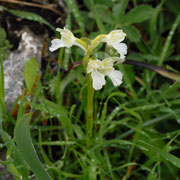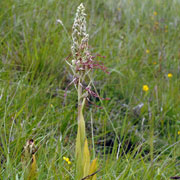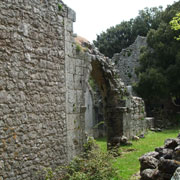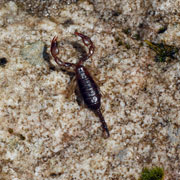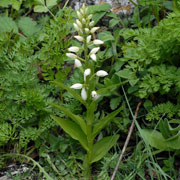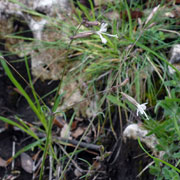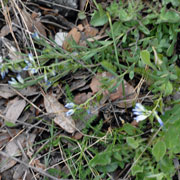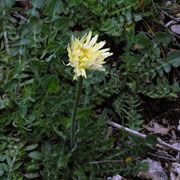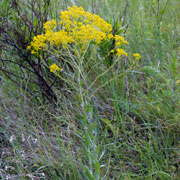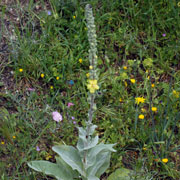Wednesday April 22nd 2009 The Ascent of Monte Sacro Stop 1
The journey to the dropping off point for Monte Sacro was quite a long one with narrower and narrower roads looking very unlikely to yield anywhere suitable for parking two large minibuses. Eventually we reached a place where there just about enough room (by British standards) to park two minibuses and to leave room for local traffic to get by. We were the first there and as we discovered later, there was enough room to allow two more Natural Holiday parties to park and allow their participants to climb the same paths up Monte Sacro.
In the first part of this walk, we searched amongst the limestone outcrops for orchids of which there were many. We noted Orchis papilionacea (Pink Butterfly orchid), Ophrys promontori (Promontory Orchid), Ophrys biscutella (Spectacled orchid), Serapias lingua (Tongue Orchid and two or three Himantoglossum hircinum (Lizard Orchid) which were in very early stages showing huge columns of buds.
H. hircinum is a British rarity but had it been in flower would have been the second largest Orchid we saw only dwarfed by Barlia robertianum (Giant Orchid). I have included a photograph of Himantoglossum hircinum (Lizard Orchid) in full flower taken in England in 2008 just to show what a splendid orchid we missed. The Orchis papilionacea (Pink Butterfly Orchid) fooled everyone at first because we knew that somewhere on this hillside we should find Orchid pauciflora (Few Flowered Orchid) and so there were confident shouts of "Over here!" until our leader pointed it out that it was an albino form of Orchis papilionacea (Pink Butterfly Orchid) not the expected Orchis pauciflora (Few Flowered Orchid).
Eventually we started to see the Orchis pauciflora (Few Flowered Orchid) and they were present in their hundreds. By the time we were seeing these flowers in good numbers some of our number were ready for a rest half way up the hill. At this point some decided not to continue to see the ruined monastery at the top but to retrace their steps and prepare lunch.
The Ruined Monastery at the summit of Monte Sacro Stop 2
Naturally I went for the climb rather than domestic duties. We found some excellent examples of Dactylorhiza romana (Roman Orchid) and eventually arrived at the monastery from which there were some splendid views. At the top someone overturned a stone and we found another Scorpion. This one was bigger, uglier and looked decidedly deadly. We looked it up in the book and found it was harmless. Nevertheless no-one was prepared to let it crawl into an uncovered hand.
On the way down we searched for another orchid Cephalanthera longifolia (Narrow-leaved or Sword-leaved Helleborine). Our orchid enthusiast found it amongst the rocks where other plants like Silene italica (Italian Catchfly), Polygala nicaeensis (Nice Milkwort) and Urospermum dalechampii (No English name) were growing. Narrow-leaved Helleborine doesn't always have narrow leaves in fact some have quite wide leaves. The difference between this and the similar Cephalanthera damasonium (White Helleborine) is that the bracts close to each flower are short in C. longifolia and long in C. damasonium.
We made our way down to the minibuses and on the way passed German party whose leader declared name of each plant with confidence as he saw it. As he passed some Smyrnium species lower down he announced this as Smyrnium perfoliatum ssp perfoliatum and I had the temerity to whisper to one of the passing their party that we had identified it was Smyrnium rotundifolium. The leader whose hearing was excellent, bounded back to insist that this was definitely Smyrnium perfoliatum ssp perfoliatum and proceeded to explain that the serrations on the upper leaves proved this. Oh yes.
After examining her photographs carefully, our leader later said she was sure that we were right all along and explained why.
This does not really mean we British are definitely better botanists but that plants conspire to fool us all just as earlier the white Orchis papilionacea (Pink Butterfly Orchid) had deceitfully pretended to be an Orchis pauciflora (Few-flowered Orchid) just to make us all look foolish.
By lunchtime there we no less than three parties at this site with all available parking places taken up. On a little grassy plateau which we had hoped to use, another nature tours company called Posh Tours inc. were setting up what looked like a full cooked lunch with champagne and butlers in attendance. Meanwhile we finished our usual excellent lunch perched precariously on some rocks by the road. Just as we finished the posh bods were beginning theirs. And at that moment it started to rain. What a shame we thought. But as we drove away the feeling of sympathy very soon passed and no doubt much sooner than it should.
Country Lane on a hillside somewhere Stop 3
On the way back we stopped in a lay-by to go for a short walk along a lane set in the hillside. The sun was out intermittently and very soon we were enjoying a splendid walk with great views into the valley. On the main road itself was tall plant with a large yellow head of flowers many of which we had passed on the coast road the day before. This was Isatis tinctoria (Woad) which at one time was common in the British Isles but which is now quite rare. On the verge itself a tall plant was coming into flower and this one was quite familiar: Verbascum thapsus (Great Mullein) which is a common plant of waste ground in Britain.
As we walked down the lane various other plants were pointed out by our leader including Satureja thymbra (Savoury) and Vicia peregrina (No English name). A shrub with broom like flowers and thorns seemed familiar because last year I saw it in a much later state of development and it took some time to identify: Calycotome infesta (Thorny Broom) has fruits which are like ordinary pods but hairy and with concave cases but none were visible on this specimen. The large pink Cistus salvifolius (Sage-leaved Cistus) was quite common but just beginning to flower along with another shrub which is common in the Mediterranean: Prasium majus (Prasium). By the track there was a small patch of very hairy Hound's-tongue with reddish flowers and again I saw much of this in Spain last year. This one is Cynoglossum cheirifolium (Mediterranean Hound's-tongue). Hound's-tongue in Britain (Cynoglossum officinale) has another identifying feature apart from its appearance: crush the leaves and they smell if mice. One of its old English names was "Rats and Mice". I didn't have time to try this test. Walking back down the lane we found a yellow vetch the flowers of which were not entirely dissimilar to the Lathyrus ochrus (No English name) found en route to the Bosco Quarto Forest but with entirely different leaves and stems of course. This was Vicia hybrida (No English name).
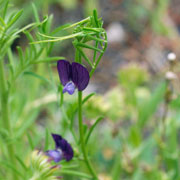
|
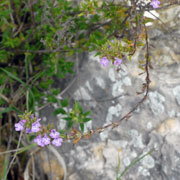
|
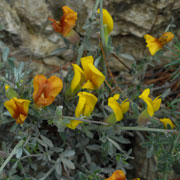
|
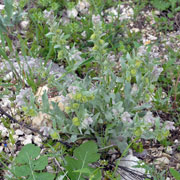
|
| Vicia peregrina No English name | Satureja thymbra Savoury | Calycotome infesta Thorny Broom | Cynoglossum cheirifolium Mediterranean Hound's-tongue |
Near Hotel Stop 4
After this short walk mostly in the sunshine we went back to the hotel and some of our party stayed in the town of Monte St Angelo to look around while I returned to the fields of our first day to re-take some photographs in much better light. This time I found three extra plants which I must have missed the first time. The first was a familiar plant of the rocks at the seaside Sedum anglicum (English Stonecrop), the second was clearly a Calamint which I think is Calamintha acinos (Basil Thyme) and the third was maybe Anthemis arvensis (Corn Chamomile).
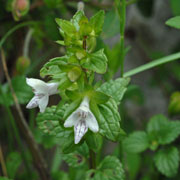
|
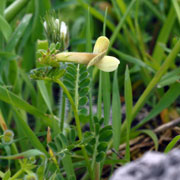
|
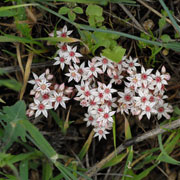
|
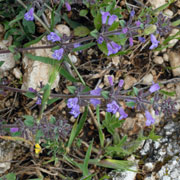
|
| Prasium majus Prasium | Vicia hybrida No English name | Sedum anglicum English Stonecrop | Calamintha acinos Basil Thyme |


